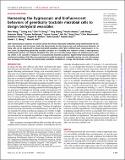Harnessing the hygroscopic and biofluorescent behaviors of genetically tractable microbial cells to design biohybrid wearables
Author(s)
Zhou, Kang; Wawrousek, Chris; Petrecca, Katherine; Wang, Wen; Yao, Lining; Cheng, Chin-Yi; Zhang, Teng; Atsumi, Hiroshi; Wang, Luda; Wang, Guanyun; Anilionyte, Oksana; Steiner, Helene; Ou, Jifei; Belcher, Angela M; Karnik, Rohit; Zhao, Xuanhe; Wang, Daniel I. C.; Ishii, Hiroshi; ... Show more Show less
Downloade1601984.full.pdf (684.9Kb)
PUBLISHER_POLICY
Publisher Policy
Article is made available in accordance with the publisher's policy and may be subject to US copyright law. Please refer to the publisher's site for terms of use.
Terms of use
Metadata
Show full item recordAbstract
Cells' biomechanical responses to external stimuli have been intensively studied but rarely implemented into devices that interact with the human body. We demonstrate that the hygroscopic and biofluorescent behaviors of living cells can be engineered to design biohybrid wearables, which give multifunctional responsiveness to human sweat. By depositing genetically tractable microbes on a humidity-inert material to form a heterogeneous multilayered structure, we obtained biohybrid films that can reversibly change shape and biofluorescence intensity within a few seconds in response to environmental humidity gradients. Experimental characterization and mechanical modeling of the film were performed to guide the design of a wearable running suit and a fluorescent shoe prototype with bio-flaps that dynamically modulates ventilation in synergy with the body's need for cooling. Keywords: bio-hybrid living actuator; humidity-responsive materials; biofluorescent behaviors; hygroscopic biomaterial pool; genetically-tractable microbial cells; multi-functional wearable devices; body heat; sweat control; ventilation modulation; bio-design
Date issued
2017-05Department
Massachusetts Institute of Technology. Department of Architecture; Massachusetts Institute of Technology. Department of Biological Engineering; Massachusetts Institute of Technology. Department of Chemical Engineering; Massachusetts Institute of Technology. Department of Electrical Engineering and Computer Science; Massachusetts Institute of Technology. Department of Mechanical Engineering; Massachusetts Institute of Technology. Media LaboratoryJournal
Science Advances
Publisher
American Association for the Advancement of Science (AAAS)
Citation
Wang, Wen et al. “Harnessing the Hygroscopic and Biofluorescent Behaviors of Genetically Tractable Microbial Cells to Design Biohybrid Wearables.” Science Advances 3, 5 (May 2017): e1601984 © 2017 The Authors
Version: Final published version
ISSN
2375-2548